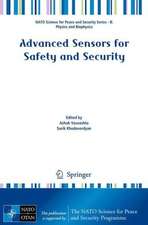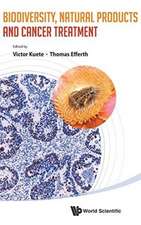Technological Innovations in Sensing and Detection of Chemical, Biological, Radiological, Nuclear Threats and Ecological Terrorism: NATO Science for Peace and Security Series A: Chemistry and Biology
Editat de Ashok Vaseashta, Eric Braman, Philip Susmannen Limba Engleză Paperback – 5 ian 2012
| Toate formatele și edițiile | Preț | Express |
|---|---|---|
| Paperback (1) | 1386.17 lei 6-8 săpt. | |
| SPRINGER NETHERLANDS – 5 ian 2012 | 1386.17 lei 6-8 săpt. | |
| Hardback (1) | 1390.89 lei 6-8 săpt. | |
| SPRINGER NETHERLANDS – 5 ian 2012 | 1390.89 lei 6-8 săpt. |
Din seria NATO Science for Peace and Security Series A: Chemistry and Biology
- 18%
 Preț: 963.29 lei
Preț: 963.29 lei - 18%
 Preț: 956.33 lei
Preț: 956.33 lei - 24%
 Preț: 789.19 lei
Preț: 789.19 lei - 15%
 Preț: 640.55 lei
Preț: 640.55 lei - 18%
 Preț: 1229.10 lei
Preț: 1229.10 lei - 15%
 Preț: 637.46 lei
Preț: 637.46 lei - 15%
 Preț: 645.28 lei
Preț: 645.28 lei - 15%
 Preț: 652.64 lei
Preț: 652.64 lei - 18%
 Preț: 949.90 lei
Preț: 949.90 lei - 5%
 Preț: 993.41 lei
Preț: 993.41 lei - 5%
 Preț: 1417.38 lei
Preț: 1417.38 lei - 18%
 Preț: 1220.45 lei
Preț: 1220.45 lei - 18%
 Preț: 944.82 lei
Preț: 944.82 lei - 18%
 Preț: 945.30 lei
Preț: 945.30 lei - 15%
 Preț: 634.00 lei
Preț: 634.00 lei - 18%
 Preț: 941.05 lei
Preț: 941.05 lei - 24%
 Preț: 789.19 lei
Preț: 789.19 lei - 18%
 Preț: 1224.36 lei
Preț: 1224.36 lei - 18%
 Preț: 1220.45 lei
Preț: 1220.45 lei - 18%
 Preț: 1222.01 lei
Preț: 1222.01 lei - 15%
 Preț: 653.65 lei
Preț: 653.65 lei - 18%
 Preț: 942.63 lei
Preț: 942.63 lei - 18%
 Preț: 941.68 lei
Preț: 941.68 lei - 18%
 Preț: 1226.73 lei
Preț: 1226.73 lei - 15%
 Preț: 640.06 lei
Preț: 640.06 lei - 18%
 Preț: 1230.35 lei
Preț: 1230.35 lei - 5%
 Preț: 1419.76 lei
Preț: 1419.76 lei - 18%
 Preț: 1223.74 lei
Preț: 1223.74 lei - 5%
 Preț: 1094.60 lei
Preț: 1094.60 lei - 18%
 Preț: 1230.03 lei
Preț: 1230.03 lei
Preț: 1386.17 lei
Preț vechi: 1690.45 lei
-18% Nou
Puncte Express: 2079
Preț estimativ în valută:
265.24€ • 276.93$ • 219.52£
265.24€ • 276.93$ • 219.52£
Carte tipărită la comandă
Livrare economică 04-18 aprilie
Preluare comenzi: 021 569.72.76
Specificații
ISBN-13: 9789400724907
ISBN-10: 940072490X
Pagini: 425
Ilustrații: XIV, 406 p. 166 illus.
Dimensiuni: 155 x 235 x 28 mm
Greutate: 0.59 kg
Ediția:2012
Editura: SPRINGER NETHERLANDS
Colecția Springer
Seria NATO Science for Peace and Security Series A: Chemistry and Biology
Locul publicării:Dordrecht, Netherlands
ISBN-10: 940072490X
Pagini: 425
Ilustrații: XIV, 406 p. 166 illus.
Dimensiuni: 155 x 235 x 28 mm
Greutate: 0.59 kg
Ediția:2012
Editura: SPRINGER NETHERLANDS
Colecția Springer
Seria NATO Science for Peace and Security Series A: Chemistry and Biology
Locul publicării:Dordrecht, Netherlands
Public țintă
GraduateCuprins
Part I. Invited and Key Lectures.- Technological Innovations to Counter CBRNE Threat Vectors and Ecotage.- Emerging Technologies: Biosecurity and Consequence Management Implications.- Bio-Inspired Computing, Information Swarms, and the Problem of Data Fusion.- Nanoparticles: A New Form of Terrorism?.- Nano Sensing Devices – Future Directions.- Metallic Films With Fullerene-Like WS2 (MoS2) Nanoparticles: Self-Lubricating Coatings with Potential Applications.- Disposable Membrane Sensors for Biohazardous Substances.- Nano-Structured Solids and Heterogeneous Catalysts: Powerful Tools for the Reduction of CBRN Threats.- Part II. Policy, Regional, and International.- Nuclear Terrorism – Dimensions, Options, and Perspectives in Moldova.- Integrative Convergence in Neuroscience: Trajectories, Problems, and the Need for a Progressive Neurobioethics.- Nanomaterials in Environmental Contamination and their Nanotoxicological Peculiarities.- The Transnistria Equation.- Part III. Chemical-Biological Sensors.- Real Time Detection of Foodborne Pathogens for Food Quality Monitoring & Biosecurity.- Nanosized and Nanostructured II-VI Semiconductors: Chemical Sensor Applications; D. Nesheva.- Nanomaterials Based Sensor Development towards Electrochemical Sensing Of Biointeractions.- Emission of Weak Electrons towards Sensing Nanoobjects.- Modeling of a New Type of an Optoelectronic Biosensor for the Monitoring of the Environment and the Food Products.- Fast, Contactless Control of the Chemical Composition of Raw Materials.- Nanoplatforms for Detection, Remediation, and Protection against Chem-Bio-Warfare.- Part IV. Synthesis/Processing.- ZnO Thin Films Deposited On Textile Material Substrates for Biomedical Applications.- Synthesis of Multifunctional Acrylic Copolymers for Chemical-Biosensors.- Synthesis of Hollow Silica Microspheres with High-Developed Surface Area.- Inorganic Nanoparticle as a Carrier for Hepatitis B Viral Capsids.-Glycerine Treatment of Poly-Perfluorosulphonic Acid Membrane Modified by Sulfonamide Groups.- Pulsed Laser Processing of Functionalized Polysaccharides for Controlled Release Drug Delivery Systems.- Exploring the Mechanism of Biomolecule Immobilization on Plasma-Treated Polymer Substrates.- Synthesis of New Carbon Compounds: N-Doped Fullerene (C50N10)O3H10 and “Pyridine” Nanocarbon.- Controlled Structure-Dependent Synthesis of Polymer/Nanosilver Composites for Highly Efficient Antibacterial Coatings.- Part V. Water – Quality, Contaminants, and Detection.- Recent Advances in Point-Of-Access Water Quality Monitoring.- Fe-Oxides in Water Remediation Technologies.- Electrochemical Oxidation of Synthetic Dyes in Simulated Wastewaters.- Electrochemical Methods for Cleansing of H2S and SO2 in Industrial and Natural Contaminated Waters.- Part VI. Information Security.- Cooperative Generation of Entangled Photons and Its Application in Quantum Cryptography.- Lithographic Limit and Problems of Two-Photon Holograms in Quantum Optics: Application in Secured Communications.- Using Informatics-, Bioinformatics-, and Genomics-Based Approaches For The Molecular Surveillance and Detection of Biothreat Agents.- Quantum Cryptography for Information-Theoretic Security.- Part VII. Radiation Sensors.- Co-operative Gamma Ray Generation Stimulated by X-Ray Pulse.- Separation of Uranium by an Extractant Encapsulated Magnetic Alginate Gels.- PBS Nanodots for Ultraviolet Radiation Nanosensor.- Overview of the Usage of Chemometric Methods for Remediation Techniques of Radionuclides.- Characterization of AU Irradiated Glassy Polymeric Carbon at 2000 ºC for Nuclear Applications.- Fiber Optic Interferometric Method for Registration of IR Radiation.- Modern Methods of Real-Time Gamma Radiation Monitoring for General Personal Protection.- Part VIII. Indexes.
Textul de pe ultima copertă
This book arises from the NATO Advanced Study Institute “Technological Innovations in Detection and Sensing of CBRN Agents and Ecological Terrorism” held in Chisinau, Republic of Moldova in June 2010. It comprises a variety of invited contributions by highly experienced educators, scientists, and industrialists, and is structured to cover important aspects of the field that include developments in chemical-biological, and radiation sensing, synthesis and processing of sensors, and applications of sensors in detecting/monitoring contaminants introduced/dispersed inadvertently or intentionally in air, water, and food supplies. The book emphasizes nanomaterials and nanotechnology based sensing and also includes a section on sensing and detection technologies that can be applied to information security. Finally, it examines regional, national, and international policies and ethics related to nanomaterials and sensing. It will be of considerable interest and value to those already pursuing or considering careers in the field of nanostructured materials and nanotechnology based sensing, In general, it serves as a valuable source of information for those interested in how nanomaterials and nanotechnologies are advancing the field of sensing, detection, and remediation, policy makers, and commanders in the field.
Caracteristici
Will be of considerable value as a secondary text for Universities currently offering courses in nanomaterials based sensing Examines how nanomaterials based sensing can be used to ensure safety of critical infrastructures of food, water, environmental, and information security for professionals working in national and international security and defense Constitutes a valuable source of information on nanostructured materials for those interested in the related aspects of the field, such as: CBRNE sensing, applications of nanomaterials and nanotechnology in environmental sensing, regional, national, and international policies in protecting critical infrastructures
















